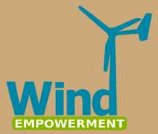| The rotors of the VIRYA-1.25, the VIRYA-1.825 and the VIRYA-2.68 windmills have two blades which are made from cambered stainless steel sheet with a constant chord. The VIRYA-1.25 has a very simple rotor, made of one stainless steel strip with cambered and twisted blades. The VIRYA-1.825 and the VIRYA-2.68 have two separate non twisted blades which are bolted to a central strip. These rotors are relatively lighter. Special tools are developed for cambering, so these rotors are very suited to serial manufacture. The blades of the VIRYA-1.25 and the VIRYA-1.825 have the same chord and can be made with the same blade press. The blades of the VIRYA-2.68 have a larger chord. The blades can be cut from standard sheet without waste material. The rotor hub, the head, the and the tower pipe are also made of stainless steel. The VIRYA-1.25 and 1.825 have a stainless steel vane blade. The VIRYA-2.68 has an aluminium vane blade. The INA Perma glide head bearings are waterproof and the mills are entirely maintenance free. These windmills have generators based on standard rotary current motors. These motors are modified with a permanent magnet armature with neodymium magnets and a stainless steel shaft. This procedure is explained in public report KD 341. The windmill rotor is mounted directly to the tapered shaft of the generator. The VIRYA-1.25 is primarily designed to be coupled to a 11 W fluorescent lamp (without battery) and for this use the standard 230/400 V winding has to be rectified in star. The VIRYA-1.25 can also be used for 24 V battery charging but then the winding has to be modified into a 115/200 V winding and delta rectification is required. The VIRYA-1.825 is primarily designed for 24V battery charging and this requires a modified 115/200 Vwinding and delta rectification. The VIRYA-2.68 uses a standard 230/400 V winding and can be used for 24 battery charging if rectified in delta and for 48 V battery charging if rectified in star. 3-phase rectification is explained in public report KD 340.A standard 230/400 V winding can be modified into a 115/200V winding by connecting the first and the second layer of the winding in parallel. The generator can be used as a brake by short-circuiting the generator winding. The generators have been tested on a test-rig at the University of Technology Eindhoven (see reports KD 18, KD 54 and KD 78). The batteries are protected against over-charging by a 27.6 V battery charge controller with dump load.The mills are provided with a “hinged side vane safety system” to limit rotor speed and thrust at high wind speeds. The rotor axis is offset from the tower axis. The vane juts out along the rotor and the vane blade is connected to the vane arm using hinges. At low wind speeds, the vane blade hangs in almost vertical position and the rotor is perpendicular to the wind. At wind speeds higher than about 6 m/s, the rotor starts to turn gradually out of the wind. At very high wind speeds the rotor turns out of the wind by about 70° and the vane blade is in almost horizontal position. The behaviour of this system is very stable and the rotor speed is well controlled. The towers consists of a 2 metre tubular upper section which can be connected to a supporting structure such as a wall of a house. If a supporting structure is not available, a 6metrelong steel tubular lower section can be used for the VIRYA-1.825. A 6 m long steel rectangular lattice tower can be used for the VIRYA-2.68. The generator, the head and the tower of the VIRYA-1.825 areidentical to those ofthe 3-bladed VIRYA-1.8and VIRYA-1.75. The head of the VIRYA-2.68 is derived from the head of the former VIRYA-2.5.The VIRYA-1.25 has been tested for about 7 year and has survived rotating, a maximum wind speed of 26 m/s. The VIRYA-1.825 and the VIRYA-2.68 havenot yet been manufactured and tested by Kragten Design. Although these mills are designed primarily for manufacture in industrialised countries, they can also be manufactured by a good workshop in developing countries. However, a prerequisite is that stainless steel is available and that one should be able to import some of the materials and standard parts. Kragten Design cannot supply materials and parts such as bearings, generators, magnets, electronics etcetera. The required workshop skills are sawing, drilling, turning, milling and welding.
|
|
Data
|
| Size |
180.12 KB |
| Author |
Dit e-mailadres wordt beveiligd tegen spambots. JavaScript dient ingeschakeld te zijn om het te bekijken. |
| Website |
Website  |
|
Download
|
|



 Renewable energy world
Renewable energy world
 Watt is duurzaam
Watt is duurzaam






